Staffordshire Bull Terries have a naturally friendly and affectionate temperament, although they have also long been seen as a dangerous breed of dog.
Other Names: Staffie, Stafford Terrier, Staff, SBT, Staffy Bull
Country Of Origin: England
Dog Group: Terrier
Size: Medium
Recommended For: Families, couples, single owners
Maintenance Level: Low
Lifespan: 12-15 years
Temperament: Affectionate, friendly, loyal
FAQ:

Good For the First-Time Owner: Maybe
Good With Children: Yes
Good With Other Animals: Maybe
Good With Strangers: Maybe
Good For Apartments: No
Exercise Requirements: Daily walking
Can Live In Hot Weather: Yes
Can Live In Cold Weather: Yes
Can Tolerate Being Left Alone: Yes
Grooming: Low
Trainability: Easy
Breed Overview:
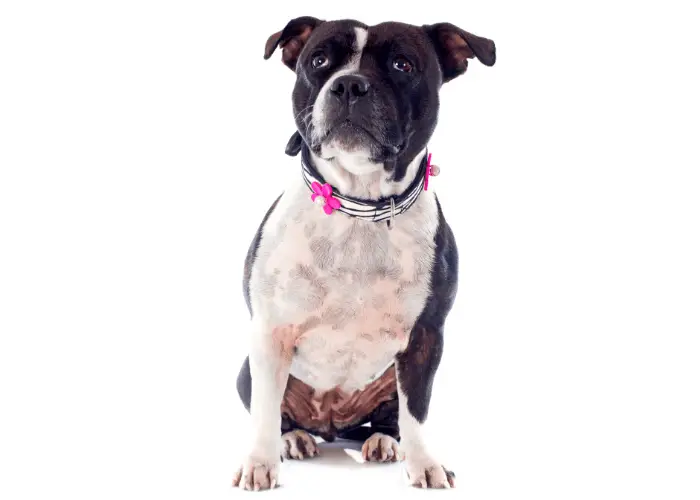
The Staffordshire Bull Terrier is a loyal breed (under the “pit bull” umbrella)that’s beginning to develop the good reputation it deserves.
While Staffies have long had a reputation for being a dangerous breed of dog, people are now starting to realize that much of this aggressive behavior was trained into them.
While they often get confused, the key difference between the Staffordshire Bull Terrier and the American Pit Bull Terrier is their size.
The Staffie is much bulkier than the Pit Bull, and in both breeds, the males have more muscle mass.
What’s more, the Staffie developed in England and the Pit Bull in America.
Color: Red, black, blue, fawn, white, or a mix
Height: 14-16 inches (both males and females)
Weight: Males – 29-37lbs, Females – 24-34lbs.
Personality and Temperament:

The Staffordshire Bull Terrier has always been known for its loyalty and is a breed that’s eager to please its owners.
The key with Staffies is for them to receive the right kind of socialization from a young age, and plenty of it.
While the breed can be trained to be aggressive, it’s entirely possible to nurture them into a calm and affectionate dog.
Start puppy training classes early, and make sure to give your Staffy plenty of love and attention.
Due to their naturally affectionate nature, Staffies are a great choice as a family dog and are great around children.
They are one of the best guard dogs as well.
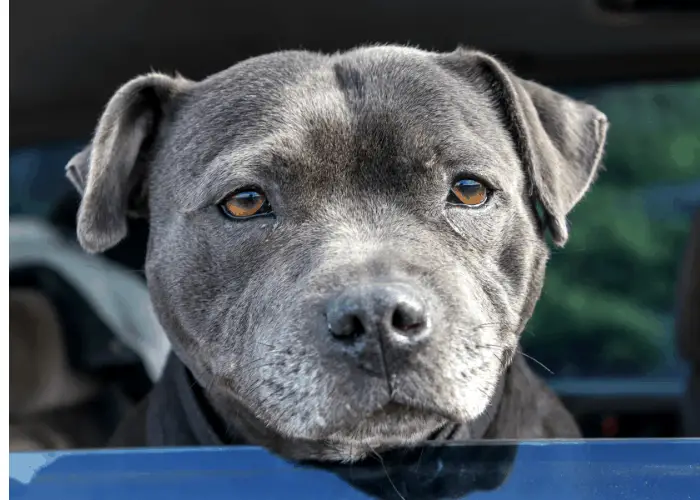
If you get a puppy, make sure to introduce it to your kids from a young age. If you adopt, however, make sure the Staffy has been raised around children.
With the right training, a Staffordshire Bull Terrier will create a loving and loyal family dog.
Much like how Staffies make a good family dog, they’re also fine to be kept around other animals.
Obviously, they should be raised around them if possible, to make things easier. While Staffies can be left alone while you’re at work, they’ll be much happier if they’ve got a friend to keep them company.
Staffies are a muscly breed of dogs but are also prone to obesity. They’re also very energetic for much of their life, and so need lots of exercise.
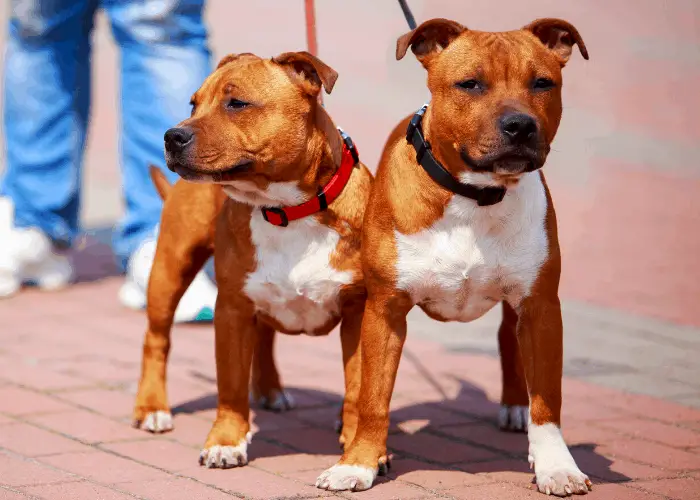
But how much exercises are lots?
Staffies should have at least an hour of good workout every day but will take as much as you can give them.
Staffies have fantastic stamina and so need long walks to stay calm.
Along with plenty of physical exercises, you should also give your Staffy lots of mental stimulation. They’re an intelligent breed, but need to keep occupied, so they don’t get bored.
Begin training from a young age and keep it up through the dog’s life. Staffies can learn quite a wide range of complex commands pretty easily.
Staffies are known to be protective breed, and how they act around strangers will depend entirely on their upbringing.
A Staffie will generally be protective around the home, but providing you’ve trained them properly there shouldn’t be any problems while out walking.
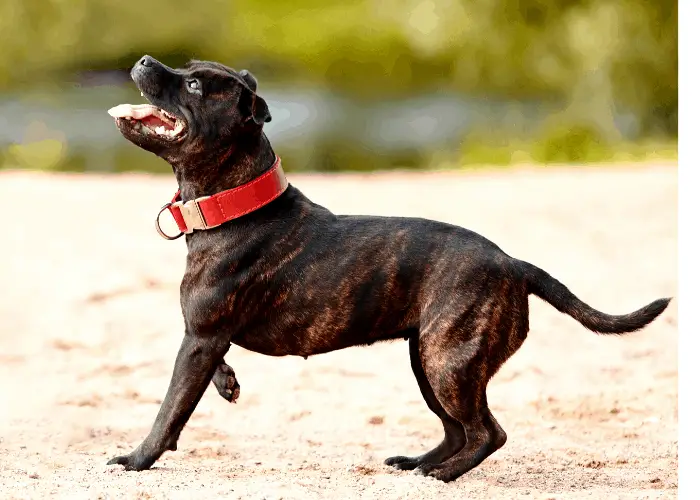
Due to their need for exercise, Staffies don’t make a good choice for apartment living. They’re energetic and need plenty of room.
If you are going to let your Staffy out in the backyard unattended, make sure it’s microchipped. Staffies can use their muscles to barge through a flimsy fence.
Staffordshire Bull Terriers have a short coat, and so are fine living in hot climates.
If you do live somewhere hot, make sure you don’t exercise them at the hottest time of the day.
Similarly, Staffies can live in colder places (they’re from England after all), but you’ll probably need to get them a coat for winter if it’s going to snow.
Grooming
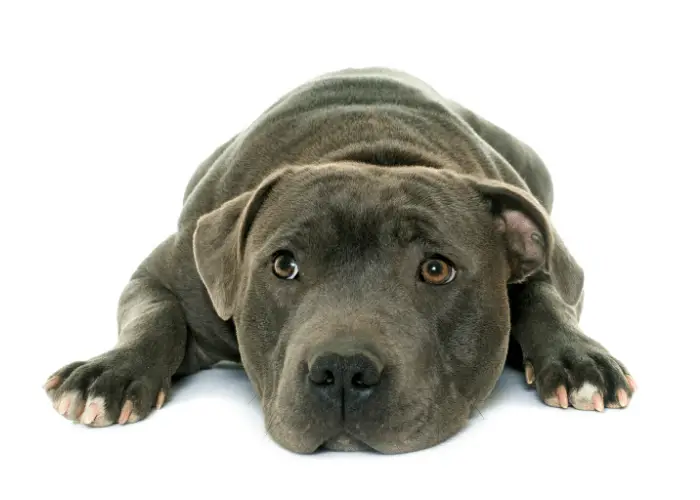
Staffordshire Bull Terriers have a short coat that comes in a variety of colors. It’s also very coarse and requires very little grooming.
A quick once over every week should be enough to keep them free of dirt and debris.
When it comes to how often you should bathe your Staffie, less often is better.
If you shower them too much, you’ll dry out their skin. Save a bath for when it’s essential, and try to solve all other problems with a brush. Staffies can develop a “doggy” smell, but this isn’t unpleasant.
It’s important to trim their nails regularly, check their ears weekly and clean when needed, and brush their teeth. These are all essential things to keep your Staffy happy and healthy.
Common Diseases and Conditions:
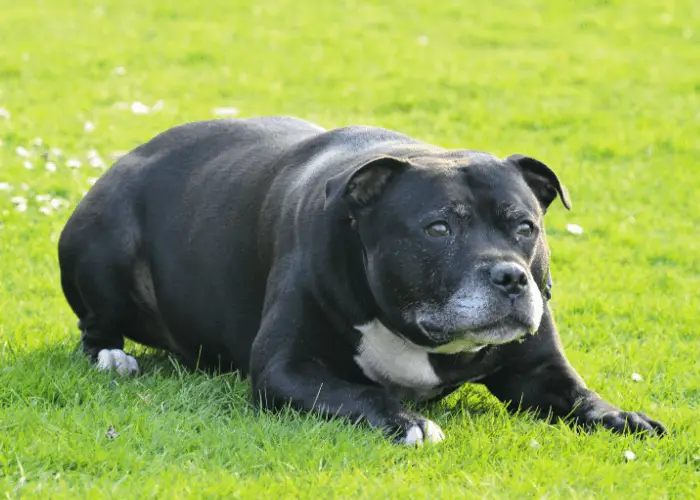
Overall, Staffordshire Bull Terriers are a healthy breed and have few health problems.
The most commonly reported disease condition in live dogs according to the
Staffordshire Bull Terrier Pedigree Breed Health Survey was hypersensitivity (allergic) skin disorder.
They also suffer from common purebred genetic conditions like luxating patellar, hip dysplasia, and cataracts.
Vets will often perform eye tests on a Staffy beginning from a young age because the breed is prone to juvenile cataracts.
Similarly, responsible Staffie breeders will screen their stock to avoid these conditions when possible.
History:

There are conflicting views about where the Staffordshire Bull Terrier actually came from.
The most widely accepted answer is that, like the American Pit Bull Terrier, it descended from the Bull and Terrier.
This breed was developed in the 19th century from working stock and is now extinct.
The reason Staffies and American Pit Bulls get confused so often are because they’re quite closely related.
In fact, many Staffy experts say that this breed is the English version of the American Pit Bull, although the breeds have developed in different ways.
At some point in the mid-19th century, a man called James Hinks took the Bull and Terrier and crossed it with the English White Terrier.
This cross had longer legs and a more refined face and eventually developed into the Staffy we know and love today.

Part of the reason Staffies have a reputation for being dangerous dogs is that they were often used for ring fighting and bull baiting.
Dogfighting in England wasn’t banned until 1911, and it still continued long after that.
It’s easy to see why Staffies still have a reputation for being dangerous, as it was just over 100 years ago that dogfighting was officially banned.
After this ban, Staffordshire Bull Terriers became a popular family and companion pet.
They’re a very popular breed in the UK, New Zealand, and Australia, which shows how they spread across the British Empire, both for fighting and companionship.
However, much of the breed’s bad reputation still persists to this day, even though many organizations and owners are working to change that.

In 2018, in the UK, PETA tried to have the Staffie added to the Dangerous Dogs Act, but this was denied.
Luckily, British institutions such as the RSPCA, Dogs Trust, and the United Kennel Club all petitioned against the proposed ban.
This at least shows that the Staffy’s reputation for being aggressive is dying out, and more people are happy to see the Staffy as a friendly and loyal dog.
The Staffordshire Bull Terrier was brought over to America in the late 19th century, and from there breeders created a slightly different dog, with longer legs and stockier body.
This dog is known as the American Staffordshire Terrier, or AmStaff for short. The AKC recognized the Staffy in 1974, and the English Kennel Club in 1935.
Did You Know?
- In 2018, a Staffy was adopted by Staffordshire Police in England to be a police dog. The Staffy, named Cooper, is the first of its breed ever to be selected for police work.
- A dog known as the Irish Staffordshire Bull Terrier is sometimes found in the UK. However, this is just an American Pit Bull and is an attempt to get the breed into the country, where it’s banned.
- Staffies are incredibly stocky, with dense muscle mass. The males have significantly more muscles than females and can be very intimidating.
- While Staffies are very energetic, they also love to cuddle and will be happiest when curled up in your lap sleeping. This is just another reason why they make a great family pet.
- It isn’t hard to find Staffies for sale. If you’re looking for a puppy, expect to pay between 1,500 and 2,500 USD, but it’ll be much cheaper if you adopt.
Love This Breed?
Check Out More Pit Bull Breeds articles below:
- Pit Bull Pros and Cons
- Why Do Pit Bull Ears Stand Up?
- How Fast Is a Pit Bull?
- Is the Amstaff a Good First Dog?
- Are Pit bulls and Staffies the Same?
- 6 Possible Reasons Why Pit Bulls Are Vocal
- Are Female Pit Bulls More Protective Than Males?
- Can a Pit Bull and Rottweiler Live Together?
- Why Do Pit Bulls Like to Sleep Under Blankets?
- Will a Pit Bull Protect Its Owner?
- Is the American Bully a Good Family Dog?
- Do Pit bulls Shed?
- Is the Amstaff a Pit Bull?
- Why are Pit Bulls So Popular?
- Will My Pit Bull Puppy Stay Blue Forever?
- American Pit Bull Terrier Temperament
- Pit Bull Puppy Growth & Development
- American Bulldog Breed Information
- American Bully Breed Information
- Amstaff Breed Information
- Pit Bull Weight Training Equipment

